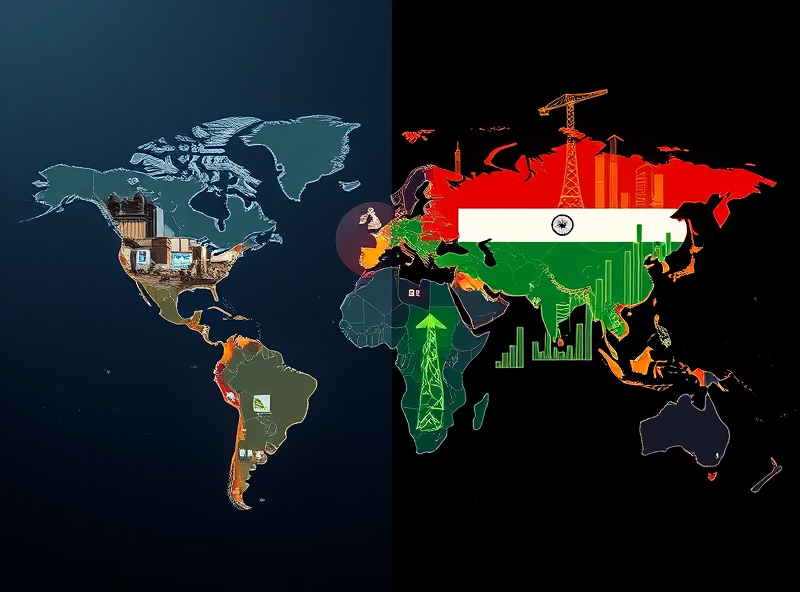
Top Investment Destinations: Developed vs Emerging Markets

Hello, fellow explorers of the financial world! As you think about where to invest your hard-earned money, the options can seem limitless, spanning across continents and economies. You might have heard terms like “developed markets” and “emerging markets” and wondered what they mean and how they differ. Is one inherently better than the other? Should you focus on familiar, established economies, or venture into faster-growing, perhaps less predictable, parts of the world? These are excellent questions that get to the heart of global investment strategy! Understanding the characteristics, potential rewards, and unique risks associated with investing in developed versus emerging markets is crucial for building a well-rounded and resilient investment portfolio. The purpose of this article is to provide you with a friendly and clear guide to these two major categories of investment destinations. We’ll break down what defines each market type, explore their respective advantages and disadvantages, and discuss how they might fit into your personal investment approach. Let’s embark on this journey to understand the global investment landscape and how you can navigate it wisely.
Defining the Landscape: Developed Markets
Let’s start with developed markets. These are generally considered countries with mature economies, stable political systems, established financial markets, and robust regulatory frameworks. They typically have high per capita income, advanced infrastructure, and a well-educated workforce. Think of countries like the United States, Canada, most Western European nations (like Germany, France, the UK), Japan, Australia, and New Zealand. Investment markets in these countries are characterized by high liquidity (meaning it’s easy to buy and sell assets), transparency, strong investor protections, and a long history of public trading. Companies in developed markets are often large, multinational corporations with established track records. While they still experience economic cycles, their economies are generally more stable and less prone to sudden, dramatic shifts compared to emerging markets.
The Appeal of Developed Markets for Investors
Investing in developed markets offers several compelling advantages, making them a core component of many investment portfolios:
- Stability and Lower Volatility (Generally): Compared to emerging markets, developed markets tend to exhibit lower levels of volatility. Their economies are more diversified and resilient, and their political systems are typically more stable. This relative stability can provide a sense of security for investors, especially those who are risk-averse or have shorter time horizons.
- Liquidity: The financial markets in developed countries are highly liquid. This means there are always buyers and sellers, making it easy to enter or exit positions quickly without significantly impacting the price. This is particularly important for large investors but also provides flexibility for individual investors.
- Transparency and Regulation: Developed markets have well-established regulatory bodies (like the SEC in the U.S.) that enforce strict rules regarding financial reporting, corporate governance, and investor protection. This transparency and oversight help reduce the risk of fraud and ensure investors have access to reliable information about the companies they invest in.
- Established Legal Frameworks: Strong legal systems in developed countries provide greater certainty regarding property rights, contract enforcement, and dispute resolution, which is crucial for investor confidence.
- Access to Large, Established Companies: Developed markets are home to many of the world’s largest and most successful companies, often leaders in their respective industries with global operations. Investing in these companies provides exposure to established businesses with proven business models.
For many investors, developed markets serve as the foundation of their portfolio due to their relative safety, liquidity, and regulatory soundness.
Potential Drawbacks of Developed Markets
Despite their advantages, developed markets also have some limitations when viewed from an investment perspective:
- Slower Growth Potential: Because their economies are already mature and highly developed, the potential for rapid, explosive growth is generally lower compared to emerging markets. Economic growth rates tend to be more modest and stable.
- Potentially Lower Returns: While stability is a plus, it often comes at the cost of potentially lower returns compared to the higher growth rates sometimes seen in emerging markets. The periods of rapid economic expansion that can fuel significant market gains are less frequent.
- Demographic Challenges: Some developed countries face challenges related to aging populations and lower birth rates, which can impact future economic growth and strain social systems.
Investors seeking aggressive growth may find that developed markets alone do not offer the highest potential returns, although they provide a crucial element of stability.
Defining the Landscape: Emerging Markets
Emerging markets, on the other hand, are countries that are in the process of rapid economic development and industrialization. They are typically transitioning from lower-income to middle-income economies and are becoming more integrated into the global economy. Examples often include countries in parts of Asia (like India, Indonesia, South Korea – though some classify SK as developed), Latin America (like Brazil, Mexico), Eastern Europe, and Africa. These markets are characterized by faster economic growth rates, younger populations, a growing middle class, and increasing urbanization. However, their financial markets and institutions are less mature than those in developed countries. Regulatory environments may be less stringent, and political systems can be less stable.
The Excitement and Potential of Emerging Markets
Investing in emerging markets can be exciting due to their potential for high returns:
- Higher Growth Potential: Emerging economies often have faster GDP growth rates than developed economies as they industrialize, urbanize, and their middle classes expand. This rapid economic growth can translate into higher revenue and profit growth for companies operating in these markets.
- Potential for Higher Returns: The higher growth potential in emerging markets can lead to potentially higher investment returns compared to developed markets. While not guaranteed, the opportunity for significant capital appreciation exists as these economies and companies mature.
- Diversification Benefits: Emerging markets often do not move in perfect lockstep with developed markets. Their economic cycles and market drivers can be different. Including emerging markets in a portfolio of developed market investments can therefore offer diversification benefits, potentially reducing overall portfolio risk and volatility (though emerging markets themselves are volatile).
- Access to Growing Consumer Bases: As the middle class expands in emerging countries, so does consumer spending. Investing in companies that cater to these growing domestic markets can provide exposure to significant new revenue opportunities.
For investors with a higher risk tolerance and a long-term perspective, emerging markets can offer compelling opportunities for growth and diversification.
The Realities and Risks of Emerging Markets
It is absolutely crucial to understand that investing in emerging markets comes with significantly higher risks compared to developed markets:
- Higher Volatility: Emerging markets are known for their higher volatility. Prices can swing dramatically and quickly due to economic instability, political events, or changes in global capital flows. This means a higher potential for significant losses in the short term.
- Political and Economic Instability: Emerging countries may face greater risks from political instability, changes in government policy, social unrest, or economic crises (like currency devaluations or high inflation). These factors can directly and negatively impact financial markets.
- Currency Risk: Investments in emerging markets are often made in local currencies. Fluctuations in the exchange rate between the local currency and your home currency (e.g., the U.S. dollar) can impact your returns. If the local currency depreciates against the dollar, your investment’s value in dollar terms will decrease, even if the investment performed well in local currency terms.
- Lower Transparency and Weaker Regulation: Financial markets and corporate governance standards in emerging countries may be less developed than in developed markets. This can lead to less transparency, less reliable financial reporting, and potentially weaker investor protections.
- Liquidity Issues: Some emerging markets may have lower trading volumes, making it harder to buy or sell assets quickly without impacting the price, especially for larger transactions.
- Potential for Corruption: Corruption can be a greater concern in some emerging markets, potentially impacting business operations and investor confidence.
These risks mean that investing in emerging markets is more speculative and requires a higher tolerance for potential losses. It’s essential to do thorough research and understand the specific risks of the countries or regions you are considering.
Choosing Your Path: Developed, Emerging, or Both?
So, should you invest in developed markets, emerging markets, or a combination of both? The answer depends entirely on your individual circumstances, financial goals, time horizon, and risk tolerance:
- Risk Tolerance: If you are very risk-averse, you might prefer to focus primarily on developed markets, which offer greater stability. If you have a higher risk tolerance and are comfortable with potential short-term losses in pursuit of higher long-term gains, emerging markets might be a suitable addition to your portfolio.
- Investment Goals and Time Horizon: If you are investing for a long-term goal like retirement (decades away), you have more time to ride out the volatility of emerging markets and potentially benefit from their higher growth. For shorter-term goals, the stability of developed markets might be more appropriate.
- Diversification: For many investors, a diversified portfolio that includes exposure to *both* developed and emerging markets offers a balance of stability and growth potential. Developed markets can provide a solid foundation, while emerging markets can offer opportunities for enhanced returns and diversification benefits that complement the developed market holdings.
- Research and Understanding: Regardless of where you invest, it’s crucial to understand what you are investing in. Research the specific countries, regions, or funds you are considering. Understand the economic and political landscape, the regulatory environment, and the specific risks involved.
For most investors seeking long-term growth and diversification, a mix of both developed and emerging markets, aligned with their risk tolerance, is often a prudent strategy. The exact allocation will vary from person to person.
How to Gain Exposure (Conceptual)
How can you actually invest in these markets? For individual investors, the most common and often recommended ways to gain diversified exposure are through investment funds:
- Developed Market Funds: These are mutual funds or ETFs that invest in a broad range of companies in developed countries. Examples include funds that track indexes like the S&P 500 (U.S. large-cap), the MSCI EAFE Index (Europe, Australasia, Far East), or global developed market indexes.
- Emerging Market Funds: These funds focus on companies in emerging economies. They might track broad emerging market indexes (like the MSCI Emerging Markets Index) or focus on specific regions (e.g., Asia Emerging Markets) or even individual countries.
- Global Funds: Some funds invest in a mix of both developed and emerging markets, often according to a specific allocation strategy.
Investing through diversified funds allows you to gain exposure to many companies across different countries within that market type, reducing the risk associated with investing in just a few individual stocks. For sophisticated investors, buying individual stocks in foreign markets is also an option, but it requires significant research into specific companies and navigating foreign exchanges and regulations.
The Complementary Nature of Developed and Emerging Markets
Viewing developed and emerging markets not as competing choices but as potentially complementary components of a global portfolio is a key insight for long-term investors. Developed markets can provide stability, liquidity, and exposure to established global leaders. Emerging markets can offer higher growth potential, demographic tailwinds, and diversification. By combining them in an allocation that suits your risk profile and goals, you can potentially create a more robust portfolio that is better positioned to capture opportunities and manage risks across the global economic spectrum. The global economy is interconnected, and a global investment approach often makes sense for long-term wealth building.
Your Global Investment Journey Starts Now!
We’ve explored the distinct characteristics of developed and emerging investment markets, highlighting the stability and transparency of the former and the higher growth potential and increased risks of the latter. Understanding these differences is fundamental to making informed investment decisions in a global context. Neither market type is inherently superior; their suitability depends on your individual investment profile. For many investors, a diversified approach that includes exposure to both developed and emerging markets offers a balanced way to pursue long-term growth while managing risk. Take the time to assess your own financial goals, time horizon, and comfort level with risk. Research diversified funds that invest in these markets and consider how they might fit into your overall portfolio strategy. Don’t hesitate to seek advice from a qualified financial advisor if you need help tailoring a global investment approach to your specific needs. By understanding the global landscape and investing thoughtfully, you can build a portfolio designed to capture opportunities wherever they arise. Wishing you insight, diversification, and success on your global investment journey! 😊







